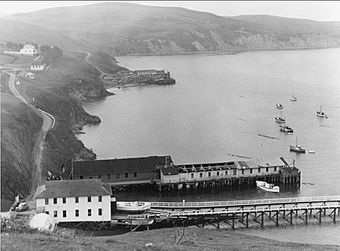Point Reyes Lifeboat Station facts for kids
|
Point Reyes Lifeboat Station
|
|

view from the west-northwest, circa 1960
|
|
| Nearest city | Inverness, California |
|---|---|
| Area | 13 acres (5.3 ha) |
| Built | 1927 |
| Architect | Maurer, Fred J.; US Coast Guard |
| NRHP reference No. | 85002756 |
Quick facts for kids Significant dates |
|
| Added to NRHP | November 7, 1985 |
| Designated NHL | December 20, 1989 |
The Point Reyes Lifeboat Station is a special historic building. It is also known as the Point Reyes Lifeboat Rescue Station. This station is found on the Drake's Bay side of Point Reyes in northern California, United States.
It was built in 1927 by the United States Life-Saving Service. This service helped rescue people from shipwrecks. The station replaced an older one from 1888. It is one of the best-kept rescue stations from that time on the Pacific coast. It still has important parts like the boat launching system.
Today, the National Park Service takes care of it. It is part of the Point Reyes National Seashore. In 1985, it was added to the National Register of Historic Places. Then, in 1989, it was named a National Historic Landmark. This means it is very important to American history.
Contents
Why Point Reyes Needed a Lifeboat Station
Point Reyes is a big piece of land sticking out into the ocean. It is north of San Francisco. For hundreds of years, it has been a major landmark for ships. But its shape and weather also made it a dangerous place. Many ships crashed there.
The point is shaped like a triangle. Its tip has parts that stick out to the east and west. The Point Reyes Lighthouse is on the western side. It faces the open Pacific Ocean. The lifeboat station is on the calmer north side of the eastern part. It faces Drake's Bay, which is more sheltered.
What is a Lifeboat Station?
A lifeboat station is a place where rescue boats are kept. It also houses the brave people who save lives at sea. The main parts of this station are a pier and a boathouse. The boathouse sits at the end of the pier, on the land.
The boathouse is about two and a half stories tall. It has a sloped roof and wooden siding. The ground floor was made to hold boats. It could fit a 36-foot (11-meter) motor boat. This was the usual rescue boat back then. It also held a smaller surfboat. The upper floor of the boathouse had rooms for the crew to live in. The chief officer had his own building. It was located further up the hill to the west.
How Boats Were Launched
One of the coolest parts of the station is the system for launching boats. There are long rails that stretch from the boathouse into the water. These rails are about 100 feet (30 meters) long. About 60 feet (18 meters) of them go into the water. On land, they rest on wooden planks. In the water, they are supported by wooden poles called pilings.
Inside the boathouse, there are special cradles. These cradles held the boats. They would slide down the rails into the water. One of these cradles still holds a rescue boat. It is named CG 36542. This boat was used when the station was actively saving lives.
History of Rescues at Point Reyes
Because Point Reyes was so dangerous, it was one of the first places on the West Coast to get a life-saving station. In 1888, the United States Life-Saving Service opened a station there. It was on Ten-Mile Beach. But launching boats from this spot was hard. The waves were too dangerous.
The current site was bought in 1913. But new buildings were not put up right away. This was because of World War I. Also, the Life-Saving Service joined with another group. They formed the new United States Coast Guard.
The station we see today was built in 1927. It helped save lives until 1968. The next year, it was given to the National Park Service. A new rescue station opened at Bodega Bay. This new station could handle the Coast Guard's bigger, 44-foot (13-meter) rescue boats.




